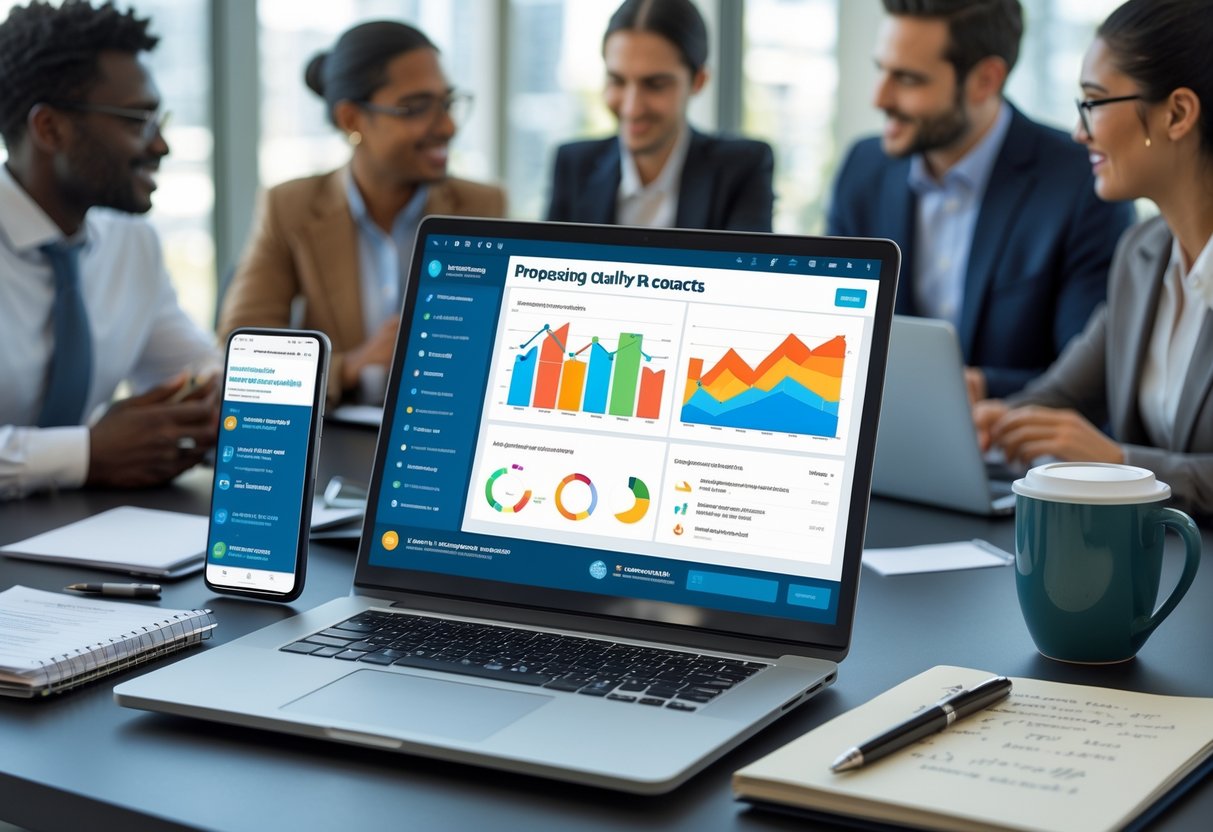Finding quality prospects doesn’t have to be such a grind. I try to zero in on people who actually need what I offer, instead of just chasing every lead that pops up.
The trick? It’s all about knowing who fits my ideal customer profile and using the right moves to reach them.

I pay close attention to signals like budget, authority, and whether they’re actually interested in buying. If I qualify and prioritize prospects, I’m not wasting time—I’m focusing energy where it counts.
That’s how my outreach gets sharper, and my pipeline actually fills with people who might say yes.
I use a mix of channels and tools—referrals, social media, prospecting software. When I stick to my criteria and keep at it, I end up with a steady stream of high-quality opportunities.
Key Takeaways
- Define who fits the profile of a quality prospect
- Use clear criteria to qualify and prioritize leads
- Apply consistent strategies and tools to find new opportunities
Understanding Quality Prospects
I care about quality prospects because they save me time and boost my conversion rates. When I know who’s worth pursuing, I stop wasting energy on dead ends.
Defining Quality Prospects Versus Leads
There’s a big difference between a lead and a quality prospect. A lead is just anyone who’s shown a bit of interest—maybe they filled out a form or downloaded something.
But a quality prospect (or qualified lead) ticks more boxes. They’ve got a real need, a budget, and the power to make decisions. Plus, they look like my ideal customer.
I don’t treat every lead like a golden opportunity. I ask questions about their pain points, timeline, and who’s calling the shots. Filtering like this keeps me from spinning my wheels.
The Impact of High-Quality Prospects on Sales Success
Focusing on high-quality prospects just makes my sales process smoother. I’m not chasing bad leads—I’m spending more time on the ones that matter.
These leads tend to move faster, too. They already know what hurts and want a solution, so the sales cycle shortens.
When I work with quality prospects, trust builds up quickly. They’re open about what they need, and I can actually help.
Key Characteristics of Quality Prospects
I look for a few clear signs when sizing up a prospect. According to this list, the big ones are:
- Awareness of need – They know there’s a problem
- Authority to buy – Decision-maker or strong influencer
- Defined urgency – They want a solution soon
- Trust in me and my company – They’re open and communicative
- Willingness to listen – They respond and value my input
If they fit my ideal buyer persona—right industry, company size, or job title—I know I’m in the right spot.
When I combine these traits with a few smart questions, I can quickly tell who’s just browsing and who’s actually serious.
Building Your Ideal Customer Profile
I build an ideal customer profile (ICP) so I’m not just guessing who to target. I look at real numbers, behaviors, and shifts in my market—no wild assumptions.
Identifying Demographics and Firmographics
First, I pin down the basics: firmographics like industry, company size, revenue, and location. If individual decision-makers matter, I check for job titles and roles.
I usually make a quick table for clarity:
| Attribute | Example Values |
|---|---|
| Industry | SaaS, Healthcare, Finance |
| Company Size | 100–500 employees |
| Revenue Range | $10M–$50M |
| Key Roles | CTO, VP of Marketing |
This helps me spot the good fits and skip the rest. I lean on data from my CRM or past deals to see which profiles actually stick around.
Analyzing Behavioral Patterns and Buying Intent
Beyond the basics, I watch how prospects behave. If they’re visiting my site, downloading stuff, or requesting demos, those are real buying signals.
I also look at how my current customers act—how they research, how long they take to buy, and what finally pushes them to act. Predictive analytics tools can help spot these trends, but sometimes you just get a gut feel.
This isn’t about personal traits—it’s about company actions. Mixing behavior with firmographics lets me target better and skip the tire-kickers.
Refining Your Ideal Customer Profile Over Time
My ICP changes as the market shifts. Every few months, I review it to make sure it still matches reality.
I use customer feedback and sales data to tweak things. If I see new industries jumping on board, I add them. If certain company sizes never stick, I cut them out.
Sharing the updated ICP with my team keeps everyone aiming at the same targets. That way, we don’t waste time on the wrong accounts.
For a more detailed approach, check out this guide on building your ideal customer profile.
Finding Quality Prospects: Strategies and Channels

I stick to channels where I can actually reach decision-makers, build trust, and attract people already interested in what I do. It’s just less hassle than chasing random leads.
Leveraging LinkedIn and Social Selling
LinkedIn is my go-to for prospecting. With Sales Navigator, I can filter by role, company size, or location—super handy for targeting.
When I send connection requests, I make each message personal. Mentioning a shared interest or industry challenge bumps up my response rates.
I post content that tackles real problems. This kind of social selling positions me as someone who knows their stuff, not just another salesperson.
Commenting with helpful insights—rather than just hitting “like”—gets me noticed. Over time, people start to see me as reliable and approachable.
Utilizing Networking and Industry Events
I show up at networking events and trade shows to meet prospects face-to-face. It’s awkward at first, but the connections are way stronger.
If I can, I check out the attendee list ahead of time and jot down who I want to meet. A couple of prepared questions go a long way.
At the event, I keep things short and meaningful. I swap contact info, connect on LinkedIn, and jot down what matters to them. Makes following up way easier.
Listening to panels gives me a feel for what’s trending. That helps me have better conversations later.
Harnessing Referrals and Mutual Connections
I ask happy clients for referrals—they already trust me, so why not? A warm intro beats cold outreach every time.
To make it easy, I’m specific: “Do you know anyone running sales at a mid-sized tech company?” It helps them think of the right person.
On LinkedIn, I look for mutual connections and ask for intros. Just a little effort here can make all the difference.
Referrals skip a lot of the awkwardness. People are more open when someone they know vouches for me.
Content Marketing and Inbound Prospecting
I put out content that draws in prospects already looking for solutions. Blog posts, case studies, and LinkedIn articles work best for me.
If I keep at it, prospects start reaching out to me. That’s the beauty of inbound prospecting—they’re already interested.
I share across LinkedIn and other social channels. Every post has a call to action—book a call, download a guide, whatever fits.
I watch the numbers: clicks, comments, shares. That tells me what people care about and helps me plan future content.
When I educate and stay visible, people see me as a resource. That draws in better leads who are more likely to stick around.
Prospecting Tools and Technology

I use a mix of platforms that help me find good data, organize leads, and save time. The right tools help me spot decision-makers, enrich contact info, and automate the boring stuff.
Essential CRM and Sales Intelligence Platforms
A CRM system is the backbone of my process. I use it to store lead info, track conversations, and stay on top of follow-ups.
HubSpot Sales Hub is one of my favorites—it keeps email, calls, and pipeline tracking all in one place.
I also use sales intelligence platforms like ZoomInfo and Cognism to get verified contacts and company data. These tools show me company size, revenue, and industry at a glance.
When I combine CRM with sales intelligence, my database stays clean and useful. I’m not guessing—I’m reaching out with real info.
Key benefits I notice:
- Centralized lead management
- Verified contact and company data
- Better alignment between marketing and sales teams
Honestly, if you’re tired of chasing bad leads, why not just skip the hassle? If you want to buy high-quality leads or need some consultation, feel free to contact me on WhatsApp at +917303556188. It’s way easier to let someone who already does this daily take care of it. Why work so hard when you can just get the right prospects delivered? I’m always up for a chat—just drop a message!
Advanced Search Filters and Data Enrichment
I rely on advanced search filters to zero in on the exact leads I want. Stuff like location, job title, company size, and industry lets me skip the noise and focus on people who matter.
LinkedIn Sales Navigator, for example, gives me detailed filters that help me spot decision-makers in the roles I’m after.
Once I’ve got a list, I go for data enrichment to fill in the blanks. A solid sales prospecting tool will pull in verified phone numbers, emails, and even tech stack info.
Honestly, this saves me hours and makes my outreach way more accurate.
Tools like Dealfront’s sales prospecting tools really show how much easier things get when you’ve got clean, enriched data.
It’s just easier to personalize my outreach, and let’s be real, that boosts response rates.
Why data enrichment?
- Keeps contact info fresh
- Cuts down on bounced emails
- Makes lead scoring actually useful
If you don’t want to spend all day digging for info, just let me handle it—feel free to contact me on Whatsapp if you need consultation or want to buy leads: +917303556188. Why make it harder than it needs to be?
AI and Automation for Prospecting Efficiency
I lean on AI-driven prospecting tools to take care of the boring stuff—sending follow-ups, scheduling meetings, scoring leads.
These tools free me up so I can actually talk to people and move deals forward.
AI helps me sift through massive lists, too. Platforms like AnyBiz use automation to pick out the best leads to hit up first.
This means I’m not just guessing who to contact.
Automation even plugs into my CRM. When I log an activity, AI reminds me what to do next or nudges me about overdue tasks.
How I use AI and automation:
- Lead scoring based on real engagement
- Email sequences that don’t sound robotic
- Smart reminders so nothing falls through the cracks
Adding AI to my stack means less manual work, more accuracy, and—honestly—more time for the stuff that actually matters.
If you want this efficiency without the headache, just reach out on Whatsapp: +917303556188. I’ll set you up with leads so you don’t have to chase them yourself.
Qualifying and Prioritizing Prospects

I always try to figure out which leads are worth the chase. I look at fit, readiness, and how much they could actually impact my pipeline.
This way, I’m not wasting time and I’m more likely to land long-term customers.
Lead Scoring and Qualification Frameworks
I score leads using clear stuff like budget, company size, and how much they’re engaging. If I don’t, I end up talking to people who’ll never buy.
BANT (Budget, Authority, Need, Timing) is my go-to. It helps me see if they’ve got the cash, the power to decide, and if they actually need what I’m offering.
I also pay attention to things like email opens, demo requests, or website visits. If someone’s active, they get a higher score.
Here’s a quick scoring table:
| Factor | High Score | Medium Score | Low Score |
|---|---|---|---|
| Budget | Has funds | Limited | None |
| Authority | Key buyer | Influencer | No say |
| Need | Urgent | Moderate | Weak |
| Timing | 0-3 months | 3-6 months | 6+ months |
I mix these up to qualify leads fast. If you want a shortcut, I can do it for you—just message me on Whatsapp: +917303556188.
Assessing Buying Intent and Pain Points
I look for signs that someone’s actually ready to buy. Stuff like downloading case studies, booking meetings, or asking about pricing—those are green lights.
I dig for pain points, too. If a company’s losing money or things are just inefficient, I show them how I can help.
I’ll ask direct questions:
- What’s your top priority right now?
- What’s holding you back?
- What’s a must-have vs. just nice to have?
If I can’t link what I offer to their pain, I move on. No point forcing it.
Prioritizing Prospects for Maximum Conversions
After qualifying, I put leads into buckets:
- Hot leads – Ready to buy, high intent.
- Warm leads – Good fit, need more info or time.
- Cold leads – Not a fit or no urgency.
This keeps things tidy and helps me focus on the ones that’ll actually convert.
If you want your pipeline to look like this, don’t stress—just ping me on Whatsapp: +917303556188. I’ll hand you leads that are already sorted and scored.
Effective Outreach and Engagement Tactics
I try to make every touchpoint count. No one likes a spammy message, so I keep things personal, use different channels, and build trust.
Personalized Outreach and Messaging
I skip generic emails—they get deleted anyway. Instead, I mention something real about the prospect. Maybe a recent company update or an industry trend.
When I write cold emails, I keep them short. Lead with value, not a laundry list of features.
Simple formula:
- Opening: Something personal or relevant.
- Value: How I can help.
- Call to action: Suggest something easy, like a quick call.
I track opens and replies with email tracking tools so I know when to tweak my approach.
If you want outreach that actually gets replies, let me know on Whatsapp: +917303556188. I’ll set you up.
Multi-Channel Outreach Strategies
I never stick to just one channel. A single cold call or email almost never works.
I mix it up:
- Cold calls with a loose script.
- Personalized emails sent at the right time.
- Social selling on LinkedIn—liking posts, sending tailored messages.
- Marketing campaigns that back up my outreach.
If someone ignores my email, I might try LinkedIn or a quick call. It’s about being present, but not annoying.
Building Trust and Credibility
Trust is everything. I use social proof—case studies, testimonials, or references.
If my product isn’t right for someone, I’ll say it. That honesty pays off later.
I don’t push too hard. I want to be seen as a partner, not just another salesperson.
Optimizing Follow-Up and Engagement
One message usually isn’t enough. Most people need a few nudges.
I space out my follow-ups and make each one useful. Instead of “just checking in,” I’ll share an article or a new idea.
I watch for when people open my emails a lot but don’t reply—that’s my cue to follow up.
For calls, I keep my script short and flexible. I want to sound real, not like a robot.
This way, I stay in touch without being annoying. If you want this kind of follow-up for your leads, just message me on Whatsapp: +917303556188.
Frequently Asked Questions
Here’s how I keep my prospecting sharp and my pipeline moving.
What are effective strategies for identifying high-potential prospects in sales?
I start by sketching out my ideal customer profile—industry, company size, buyer role.
Then I use stuff like LinkedIn Sales Navigator or B2B databases to find matches.
Events and webinars help me meet people who already care about what I do.
What criteria should be used to qualify a lead as a prospective client?
I look for budget, authority, need, and timeline (BANT).
If they’ve got the money, power, a real problem, and a reasonable buying window, they’re in.
I also check if they actually fit what I’m selling and if they’re engaged.
What are the most successful prospecting methods used in network marketing?
Honestly, personal connections and referrals win every time.
I build relationships at events, on social, and in one-on-one chats.
Consistent follow-ups and sharing good info keep me top of mind.
How can businesses effectively utilize the 5 P’s of prospecting to find quality leads?
I use the 5 P’s—Preparation, Prospects, Pitch, Persistence, and Personalization.
I prep by researching, I personalize every message, and I keep following up.
Refining my pitch helps me get my value across without rambling.
In what ways can the 70/30 rule in sales be applied to prospecting for better results?
I try to listen 70% of the time and talk 30%.
That way, I actually hear what the prospect needs.
Open-ended questions get them talking, and I can connect my solution to what matters to them.
If you want to skip all this and get leads delivered, just reach out on Whatsapp: +917303556188. Seriously, why work harder than you need to? I’ve done the heavy lifting so you don’t have to.
What techniques can marketers employ to ensure a steady pipeline of qualified prospects?
Honestly, keeping a steady stream of good leads isn’t magic—it’s a mix of smart tactics and a bit of hustle. I lean on content marketing, referrals, and targeted outreach to keep things moving.
Prospecting tools like ZoomInfo or Hunter? Super useful for checking contact details and making sure you’re not wasting time.
I also make it a point to follow up regularly. Sometimes I’ll offer a demo or toss out a free resource just to keep prospects interested.
If you’d rather skip the grind and just get high-quality leads, feel free to contact me on WhatsApp at +917303556188. Why work so hard when you can let me handle it?



